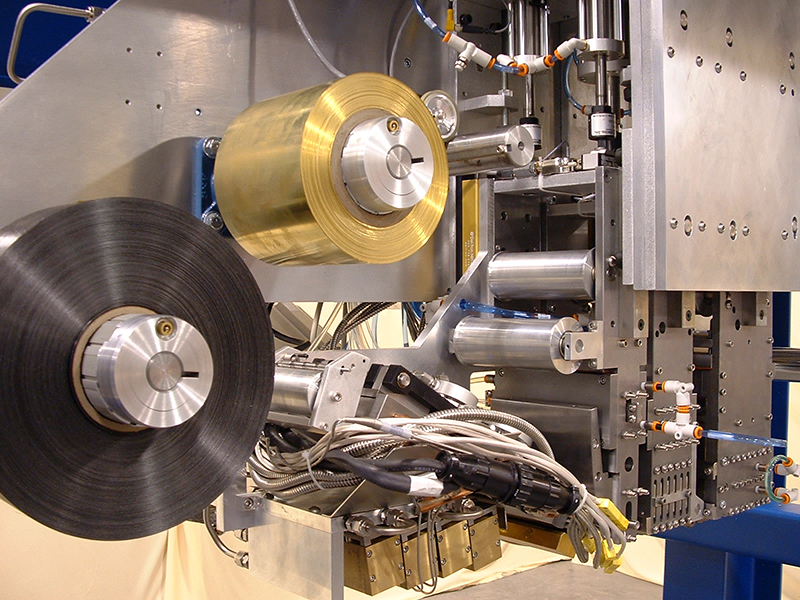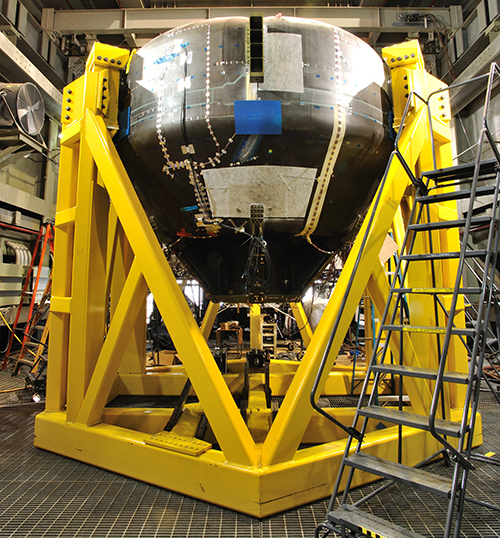
Custom Machines Advance Composite Manufacturing
NASA Technology
Here is a brief list of materials that NASA will not be using to construct spacecraft: wood, adobe, fiberglass, bone. While it might be obvious why these materials would not make for safe space travel, they do share a common characteristic with materials that may well be the future foundation of spacecraft design: They all are composites. Formed of two or more unlike materials—such as cellulose and lignin in the case of wood, or glass fibers and plastic resin in the case of fiberglass—composites provide enhanced mechanical and physical properties through the combination of their constituent materials. For this reason, composites are used in everything from buildings, bathtubs, and countertops to boats, racecars, and sports equipment.
NASA continually works to develop new materials to enable future space missions—lighter, less expensive materials that can still withstand the extreme demands of space travel. Composites such as carbon fiber materials offer promising solutions in this regard, providing strength and stiffness comparable to metals like aluminum but with less weight, allowing for benefits like better fuel efficiency and simpler propulsion system design. Composites can also be made fatigue tolerant and thermally stable—useful in space where temperatures can swing hundreds of degrees.
NASA has recently explored the use of composites for aerospace applications through projects like the Composite Crew Module (CCM), a composite-constructed version of the aluminum-lithium Multipurpose Crew Capsule. The CCM was designed to give NASA engineers a chance to gain valuable experience developing and testing composite aerospace structures.
Partnership
Composites are an increasingly significant part of terrestrial applications, from transportation (the largely plastic composite airframe of the new Boeing 787 Dreamliner, for example) to medicine (composite prostheses among other uses). As the composites industry has matured, says Brian Jensen, materials scientist at Langley Research Center, NASA “started an effort to not only improve the performance of composites, but also to lower the cost.” Cost is a major challenge to composite manufacturing. Composites are traditionally fabricated by layering prepreg materials—sheets of reinforcement material, such as carbon fiber, already pre-impregnated with the bonding resin—in a mold, either by an automated process or, often, by hand. The mold is then placed in an autoclave, a pressurized oven, to cure. Large composite structures like parts of rockets, airplane wings, and wind turbine blades require massive, extremely expensive autoclaves for curing.
To help develop less costly, out-of-autoclave composite manufacturing techniques, Langley partnered with Accudyne Systems Inc., of Newark, Delaware, through the Small Business Innovation Research (SBIR) program. Through this partnership, Accudyne applied its expertise in creating custom automation equipment for composite manufacturing to develop an automated thermoplastic tape laydown head. Unlike a thermoset composite, which once cured cannot be reshaped or reprocessed, a thermoplastic can be reheated for remolding or to heal flaws in its structure. The Accudyne device deposits preheated strips of the thermoplastic materials, welding the strips together through heat and pressure to build up structures layer by layer—eliminating the need for an autoclave.
“It’s been a dual effort between Langley and Accudyne, where Langley is trying to develop the thermoplastics that work well, and Accudyne has been fine-tuning the heated head to make this process happen in a reasonable time and yield a high-quality part,” Jensen says.
Benefits
While the tape laydown head currently features as part of an Accudyne-built machine at Langley, the company’s SBIR work has yielded technology for its commercial products, as well. Autoclave-cured thermoset materials still dominate composites manufacturing, explains John Melilli, Accudyne’s vice president of sales and marketing, and the company’s commercially available deposition heads for thermoset systems employ technology created for the SBIR-developed laydown head. Through another NASA SBIR, Accudyne also developed nanoparticle technology that, when mixed with a composite resin, helps the material develop improved properties—allowing high-quality parts to be made more quickly at lower cost, Melilli says. The company has patented the innovation and expects significant commercial interest.
Accudyne is currently working with major aerospace companies to develop machines for manufacturing composite rocket parts and components for helicopter rotors. The company’s automated solutions enable the production of higher quality parts at lower costs, while not threatening the jobs of the workers who previously fabricated the composite parts by hand.
“This is not about replacing people with machines,” Melilli says. “The people end up working with the machines, and the rate of production goes up.”
The kind of support that NASA has provided to composite manufacturing innovators like Accudyne has been essential to the continued development of the entire industry, Melilli notes. “The reality is that the work, connections, and references that NASA has continued to provide have been crucial to keeping this technology going.”
In a broader sense, he says, “NASA’s support of manufacturing in general is important to maintaining and advancing the Nation’s technological capabilities. Manufacturing is so important because you end up applying all of the process lessons you have learned over time. The United States runs the risk of falling behind in developing new processes and manufacturing technologies if, as is the current trend, manufacturing continues to migrate to foreign countries. We end up being ‘distributors’ as opposed to ‘manufacturers.’ The skills are different and the compensation is as well.”
This learning process is still very much underway at Langley, where the Accudyne-built machine is available for researchers and partners in private industry to use.
“That machine is going to be indispensable in helping to develop a database of processes and parts made from thermoplastics,” Melilli says. In the meantime, Accudyne is currently engaged in a Small Business Technology Transfer (STTR) project with Langley and the University of Delaware to improve the properties of parts made with the SBIR-derived tape laydown head.
The results indicate a bright future for out-of-autoclave thermoplastics manufacturing. Jensen notes that these parts initially exhibited performance properties 70–80 percent of those made using an autoclave. Through the STTR partnership, those results are now around 90–95 percent

The Composite Crew Module allows NASA researchers to test materials and methods that may one day be applied to spacecraft constructed using composite materials.

The automated thermoplastic tape laydown head developed by Accudyne Systems Inc. provides Langley Research Center engineers and others with a unique tool for advancing out-of-autoclave thermoplastics manufacturing.













